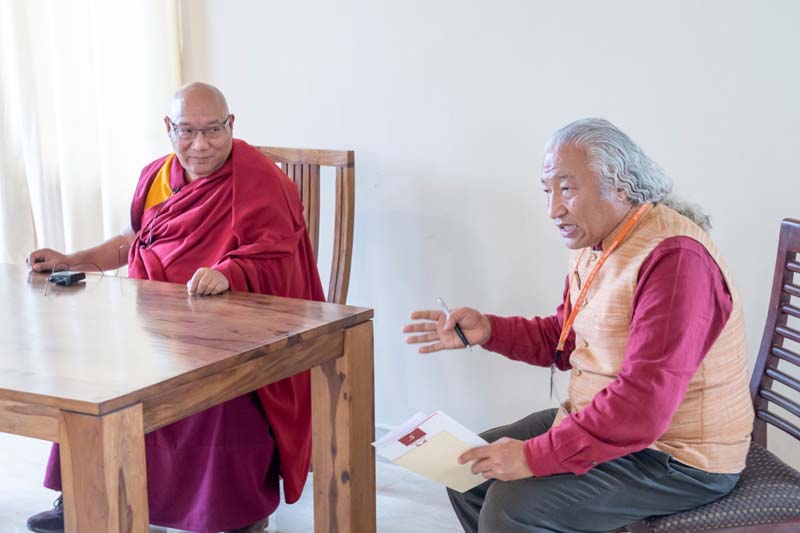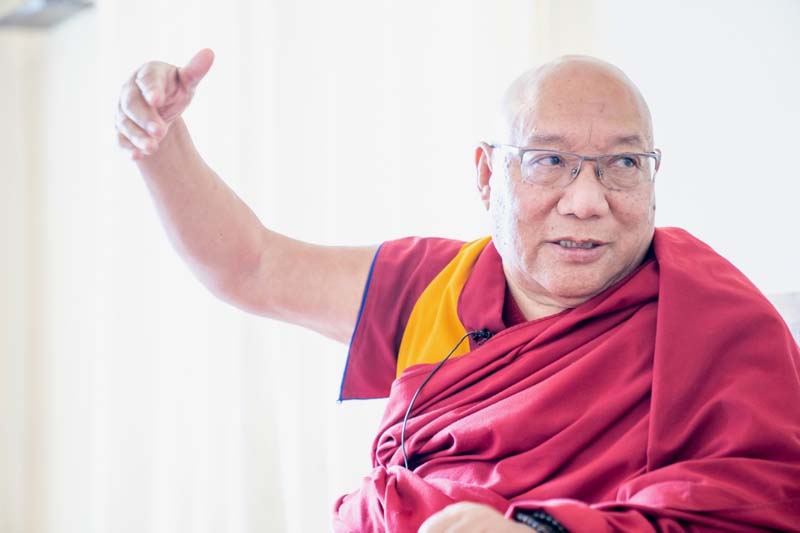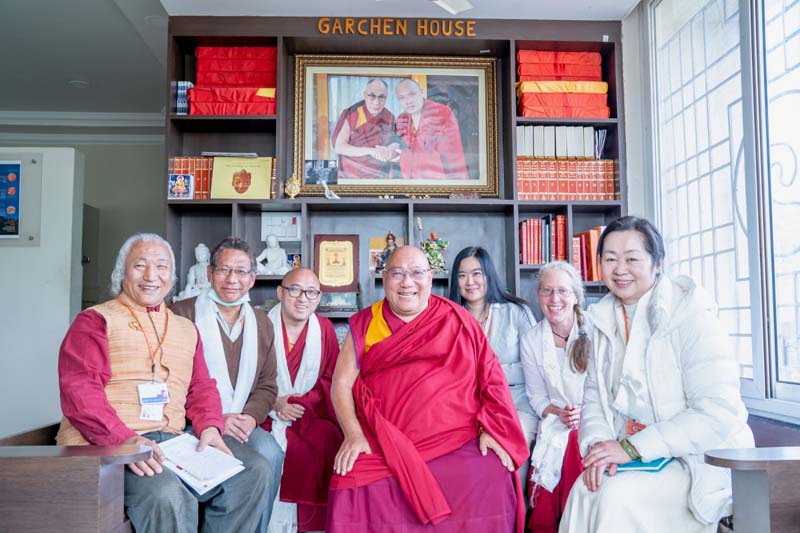
Garchen House, Bodhgaya,
February 8, 2020
The Kagyu Monlam publicity team was lucky to have the chance to interview Khenpo Lodro Donyo Rinpoche, Bokar Yangsi Rinpoche’s tutor, who generously shared his thoughts with us on the day following the auspicious occasion of bestowing Barma Rabchung vows on the young tulku. Ngodup Tsering translated. An edited transcript follows.
Publicity Team (PT): Could you please share some thoughts about the ordination of Bokar Yangsi Rinpoche yesterday, and some general background?
Khenpo Lodro Donyo Rinpoche (KLDR): In general, there are stages of vows. The first is taking the refuge vow and entering the path of the dharma. After Bokar Yangsi’s recognition by His Holiness [the 17th Karmapa] in 2015, we had the official ceremony here in Bodhgaya, and during that time, His Holiness personally offered the refuge vow. The second phase can be a combination of what we call Yongdzok Genyen— that is, the most complete form of the upsaka vows or lay precepts— as well as the intermediate or preliminary novice monks’ vows, known in Tibetan as Barma Rabjam. So His Holiness’s instruction, after recognition and giving refuge, was to have Rinpoche stay, in appearance, like a regular child, not as an ordained monk — keeping his hair and not donning the dharma robes. So for the past five years, outwardly, Rinpoche has seemed that way. Yet at the same time, in the monastery, he has received all the trainings in accordance with his preparation for monk-hood. So that’s how it has been done. Now, recently, we received word from His Holiness that the second stage of the vow can be conferred on Rinpoche. And His Holiness also gave instruction: it should be done in Bodhgaya, during the Kagyu Monlam, and specifically on the day there is the Procession of the 16 Arhats and the rituals for the flourishing of the dharma. So in this way, the second phase of the vow happened, as you all know.
To finish this discussion, the next level of vows is the novice monk’s vows, or Getsul ordination. This can be given anytime before somebody turns twenty years old. Then, the Gelong ordination [the full and complete version of the monastic vows] is generally given after one turns twenty. So, His Holiness’s instruction is that, in due time, these vows could follow and Rinpoche can receive them at the appropriate time. They will happen, but we don’t know when.
PT: Can you offer us some guidance about reporting on the vow ceremony? We found out later that we probably shouldn’t even having been there [since we are not ordained sangha]. We were told not to publish photos of the ceremony, because it was private.

Ngondrup Tsering translating during the interview with Khen Rinpoche
KLDR: Yes, it’s true; according to the Vinaya tradition, when receiving monk’s ordination, that should be done privately, in terms of the place; and the ceremony should be done privately, that is, those not receiving the vows are not allowed to hear the words of the repetition of the vows. That is the specific wording of the Vinaya. Again, though, there are stages of vows, and the least stringent are the lay precepts and the intermediate or preliminary novice ordination, which was the case this time. With Getsul and Gelong ordination, it’s absolutely true: nobody should be there, nobody should hear anything. It should be strict. This time, we can say, there’s a bit of an exception. That is: we chose the place— under the bodhi tree — and the bodhi tree is certainly not a private place. So we chose it, and having done so, while gaining the benefit of being under the bodhi tree, we also had to accept that this is a public area. We cannot say ‘You cannot come, you cannot come’ and so forth. Because of the circumstance, we had to strike this kind of balance. So, to that extent, it’s OK. But when His Eminence Gyaltsap Rinpoche was actually giving the vow, and Yangsi Rinpoche was repeating it, although you were present, you didn’t hear the words, and you didn’t understand the meaning. So Rinpoche was there doing it quite privately. In that way, the main principle remained intact. Now, traditionally, in cases of ordination, there must be a minimum of five fully ordained monks. So, in this case we had, of course, the principal one—His Eminence Gyaltsap Rinpoche; and then we had Zurmang Garwang Rinpoche, Yongey Mingyur Rinpoche, and then the retreat master from Gyaltsap Rinpoche’s monastery, Topden Tendzin Gyurme; and then myself. So we four assisted Gyaltsap Rinpoche. Maybe it was not apparent, but each one had a specific role.
PT: We heard some stories that the robes had already been prepared for some time, and Bokar Rinpoche could not wait to wear them. May we know some of his feelings about the ordination?
KLDR: Yes, personally, Bokar Yangsi Rinpoche has very strong feelings of wanting to take monk’s ordination and don the dharma robes. That is very strongly inborn with him. He expressed, a number of times, how eager he was to wear the dharma robes. Even when coming to Bodhgaya this time, he said, “This will be the last time I’ll be putting on lay clothes.” And this is born from very strong feelings based on his previous wholesome habits. And Rinpoche has, on several occasions, expressed a wish to take on the dharma robes. In fact, Bokar Yangsi Rinpoche directly conveyed this feeling to Yishin Norbu [the 17th Gyalwang Karmapa] himself, directly. His Holiness told him to wait, meaning that in due time, when His Holiness sees fit, he will say so. So yes, it is absolutely true. He has very strong feelings, and I repeat, it must be a carry-over from his previous lifetime. This time, when he had the chance to put on the robes, he was very happy and went right into it. And in fact, when you asked this question and I’m answering, my emotions came up, because it was, I felt, a connection to his previous lifetime.
PT: Can you share your wishes for Rinpoche’s future with us? Do you have hopes for what kind of master Rinpoche will be?
KLDR: Of course, we all have aspirations. This is true for everybody and certainly for Rinpoche. For someone like him, and others like him, it is very important that one maintain the outer Vinaya vows— the pratimoksha or self-liberation vows— and the inner bodhisattva vow, meaning to maintain the resolve of bodhicitta, and following or integrating the bodhisattva guidelines. That is how one maintains it. Then, the secret or higher Vajrayana or tantric vow— with all the necessary facets involved — for a great master, what we wish most for is one who upholds the so-called Three Vajras of outer Vinaya, inner bodhisattva, and secret Vajrayana vows. And, through upholding and maintaining the three vows intact, then, benefitting the dharma and beings — that is, serving the dharma, benefitting the cause of beings. Speaking more specifically: [our wish is for Rinpoche to] follow all the wishes of Yishin Norbu, and those of all the other teachers. And then, of course — to be able to walk in the footsteps of his predecessor, the previous Bokar Rinpoche.

PT: Is the Barma Rabchung basically equivalent to the most complete form of the lay upasaka vows?
KLDR: No, there is a distinction. The Barma Rabchung is a bit higher than the lay precepts, in that here, [you are] taking the vow that in the future, I will uphold the vows that the buddha himself has taken and upheld. I will also, down the road, uphold them. So it’s like making the aspiration, or resolve, to be able to do that. That leads to Getshul ordination. On top of that, it’s taking the vow to don the 3 dharma robes with the blessings they convey, and to be able to take possession of the robes and the renunciate’s begging bowl. In the vow ceremony, each part of the robes and each object is blessed: “Now, you can take ownership of these objects.” So in this way, it’s quite different.
PT: Can you say more about the different levels of the vows? What is the difference between the Barma Rabchung and the Getsul or Novice ordination vow? [Translator comment: the term”intermediate” suggests the Barma Rabchung is in-between the lay vows and the Getshul vows; but for a monastic, it really makes more sense to label the Barma Rabjam a Preliminary vow, since it is the first level of ordination.]
KLDR: There is a distinction between the full lay precepts and the Barma Rabchung in that, in Barma Rabchung, on top of the lay precepts, one makes a vow to change one’s outward appearance — donning the robes of a renunciate. That’s one; and then, discarding the appearance of a lay person, that’s two. And then, changing the name from a lay name to the name of a renunciate: that’s three. So these three are special to the Barma Rabjam. After than come the Getshul vows, and at that time, of course, it would be explained, what are the additional vows one would take, and the rules one has to follow. The other clarification is the difference between refuge, lay precepts, intermediate, Getsul, and so forth: these first four can be given in the course of one day, each one done in order. They are sequential. You cannot receive the second one without having received the first one. But you can receive, based on time and circumstance, all four in one day; or they can be given on separate occasions, in order. The only condition, again, is age. In order to receive the Gelong or full Bhikshu ordination, you must be at least twenty. For the other vows, age is not an issue.
PT: One member of our team is making a documentary about Bokar Rinpoche. Her question is what kind of feeling Khenpo Rinpoche had, the first time you met Bokar Yangsi Rinpoche, five years ago. Can you share your reaction?
KLDR: Most significantly, my feeling was that, being very familiar with the previous Bokar Rinpoche, when seeing Bokar Yangsi Rinpoche for the first time— with the exception of a change in his appearance, in this small body, the mind of the previous one was very apparent. That was really the key.
PT: Any further details of this meeting would be wonderful, if you can share any stories.
KLDR: Another element is that Rinpoche was recognized in accordance with a letter of recognition made by His Holiness the Karmapa. In that letter of recognition, everything was mentioned very precisely: the landscape of the place he was born — where the streams ran or what have you — the number of individuals in that family, the age, or the year of his birth, and so forth. It was 100%. In accordance with that letter, we found him. So, to that extent, what His Holiness did was amazing. What we found matched exactly what the map in the letter contained. On top of that — it’s like, this was enough that we could trust, 100% — but in case we needed more, through meeting the little boy, Rinpoche, our feelings also resonated with His Holiness’s recognition. So therefore our faith in His Holiness grew stronger, as well as our faith that what has been found is unquestionably the real one. And also — this probably you know if you read any of the information we previously released — we went back and forth with His Holiness and put all the information together, so we could not have been any happier or more thoroughly confident that, through His Holiness’s unveiled wisdom, we found the authentic reincarnation of Rinpoche. We are 100% sure.
As a side note to the letter of recognition, His Holiness scribbled in the margin: “Number of family: 5, or 6?” It’s like, are you not so sure? So, we found Rinpoche has his parents, two sisters, and him — five. Then, there is a step-daughter: I think, mother’s sister-or-brother’s daughter that they had adopted before they had any children. So in terms of blood relations, Rinpoche has two sisters — that makes five. But there is a 6th one in the family also, if you want to include that one — it’s up to you. There are five, and maybe the sixth one if you want to include her.
Now this isn’t about Bokar Rinpoche. When it came to Tenga Rinpoche’s recognition, he put a similar note: “In the family, 4 and a half.” So then, when they went to search, there were the parents, and Rinpoche’s sister, and Rinpoche — four. And then, of course, the mother is almost six months pregnant. So, His Holiness saw not only what was outside; he saw what’s inside, too.
PT: Thank you so much Rinpoche.
KLDR: You are welcome.


































